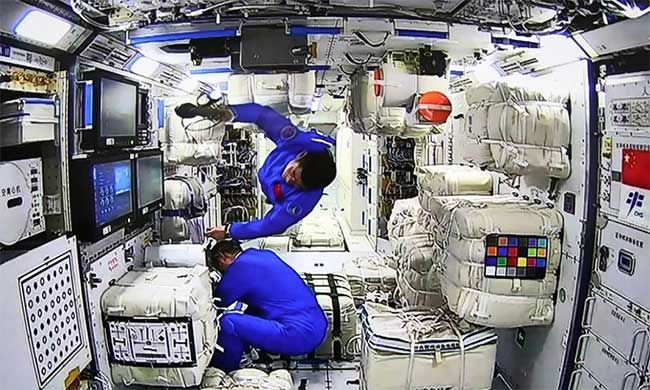Shenzhou 12 spacecraft docked with the Tianhe module approximately 6 hours after launch, successfully bringing 3 astronauts into orbit.
Three Chinese astronauts arrived at the new space station on June 17, beginning a 3-month mission that marks a significant milestone in the country’s space program. The Shenzhou 12 spacecraft connected with the Tianhe module of the Tianhe Station about 6 hours after taking off from the Jiuquan Satellite Launch Center at the edge of the Gobi Desert.
Astronauts inside the Tianhe module. (Video: CCTV).
About 3 hours later, commander Nie Haisheng (56 years old), followed by Liu Boming (54 years old) and Tang Hongbo (45 years old), opened the module door and floated inside. Photos captured the moment they were busy unpacking equipment.
The crew will conduct experiments, check equipment, perform maintenance, and prepare to receive two experimental modules next year. This mission raises the number of Chinese astronauts who have flown into space since 2003 to 14, placing China behind only the Soviet Union and the United States.

Chinese astronauts enter the Tianhe space station.
On the morning of June 17, the Long March 2F rocket carrying the Shenzhou 12 spacecraft lifted off from the launch pad at 8:22 AM Hanoi time. The booster separated from the rocket about 2 minutes later. After 10 minutes, the Shenzhou 12 separated from the upper stage of the rocket, deployed its solar panels, and entered orbit shortly thereafter. Several adjustments took place in the following 6 hours to ensure the spacecraft docked with the Tianhe module at 3 AM on June 18, Hanoi time.
The travel time has been significantly shortened from the previous two days, a result of numerous breakthroughs and technological innovations, according to Deputy Chief Designer Gao Xu. This allows astronauts more time to rest and reduces fatigue. Other improvements include an increase in the number of automated and remote control systems, significantly alleviating pressure on the astronauts.


















































